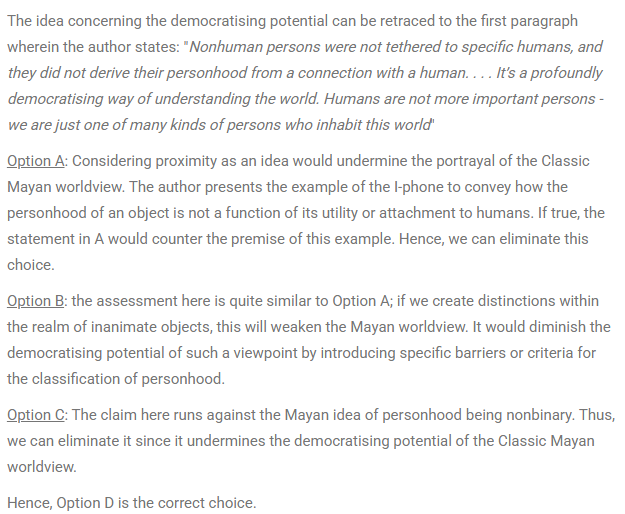CAT RC Questions | CAT RC Based on Humanities questions
FundaMakers is the Best CAT Online Coaching In India. Now prepare for CAT anytime with FundaMakers. We provide well-ordered syllabus coverage for both offline and online CAT preparation batches. FundaMakers brings to you the power-packed, well-structured CAT previous year question bank with more than 4000+ CAT Past Year questions. In the VARC section, one of the most frequently asked questions is from the topic- Reading Comprehension. Reading Comprehension turns out to be an important part of the VARC section from which over 60-70% of the questions are based on RC in the CAT Exam.
FundaMakers as a team has taken a painstaking step to bring you all the video solutions of the Reading Comprehension asked in the Previous Year CAT exam. CAT question bank offered by FundaMakers is a power-packed topic-wise compilation of the entire CAT previous year questions. Questions from the Reading Comprehension topic are some of the most scoring questions in the VARC section. To maximize your CAT score make use of FundaMakers CAT Question Bank. “Questions from CAT previous years” examination papers have been incorporated. Let’s get started with CAT Past Year Reading Comprehension Questions.
Comprehension
Directions for the questions: The passage below is accompanied by a set of questions. Choose the best answer to each question.
For the Maya of the Classic period, who lived in Southern Mexico and Central America between 250 and 900 CE, the category of ‘persons’ was not coincident with human beings, as it is for us. That is, human beings were persons – but other, nonhuman entities could be persons, too. . . . In order to explore the slippage of categories between ‘humans’ and ‘persons’, I examined a very specific category of ancient Maya images, found painted in scenes on ceramic vessels. I sought out instances in which faces (some combination of eyes, nose, and mouth) are shown on inanimate objects. . . . Consider my iPhone, which needs to be fed with electricity every night, swaddled in a protective bumper, and enjoys communicating with other fellow-phone-beings. Does it have personhood (if at all) because it is connected to me, drawing this resource from me as an owner or source? For the Maya (who did have plenty of other communicating objects, if not smartphones), the answer was no. Nonhuman persons were not tethered to specific humans, and they did not derive their personhood from a connection with a human. . . . It’s a profoundly democratizing way of understanding the world. Humans are not more important persons – we are just one of many kinds of persons who inhabit this world. . . .
The Maya saw personhood as ‘activated’ by experiencing certain bodily needs and through participation in certain social activities. For example, among the faced objects that I examined, persons are marked by personal requirements (such as hunger, tiredness, physical closeness), and by community obligations (communication, interaction, ritual observance). In the images I examined, we see, for instance, faced objects being cradled in humans’ arms; we also see them speaking to humans. These core elements of personhood are both turned inward, what the body or self of a person requires, and outward, what a community expects of the persons who are a part of it, underlining the reciprocal nature of community membership. . . .
Personhood was a nonbinary proposition for the Maya. Entities were able to be persons while also being something else. The faced objects I looked at indicating that they continue to be functional, doing what objects do (a stone implement continues to chop, an incense burner continues to do its smoky work). Furthermore, the Maya visually depicted many objects in ways that indicated the material category to which they belonged – drawings of the stone implement show that a person-tool is still made of stone. One additional complexity: the incense burner (which would have been made of clay, and decorated with spiky appliques representing the sacred ceiba tree found in this region) is categorised as a person – but also as a tree. With these Maya examples, we are challenged to discard the person/nonperson binary that constitutes our basic ontological outlook. . . . The porousness of boundaries that we have seen in the Maya world points towards the possibility of living with a certain uncategorisability of the world.
CAT/2021.1
Question . 18
Which one of the following, if true, would not undermine the democratising potential of the Classic Maya worldview?
Explanatory Answer
Method of solving this CAT RC Question from RC Based on Humanities question
Correct Option: D

Hey!
Worried about IIM calls due to your marks in 10th,12th, and Graduation?
Don't worry! Know your chances of getting an IIM Call based on your profile with our:-
Profile Professor: https://fundamakers.com/profile-professor/

5 Must- NOT-Dos during CAT Preparation.
- Do not treat CAT as 'Everything'.
- Do not quit your job for CAT exam preparation.
- Learning till The Eleventh hour instead of doing proper revision.
- Not checking the syllabus thoroughly.
- Piling up multiple books.
Click To Read:- Common mistakes made by CAT aspirants during preparation.
FundaMakers- Best Online and Offline CAT Online Preparation Institute in India
For any CAT Preparation related query, reach out to us at 9598333344.